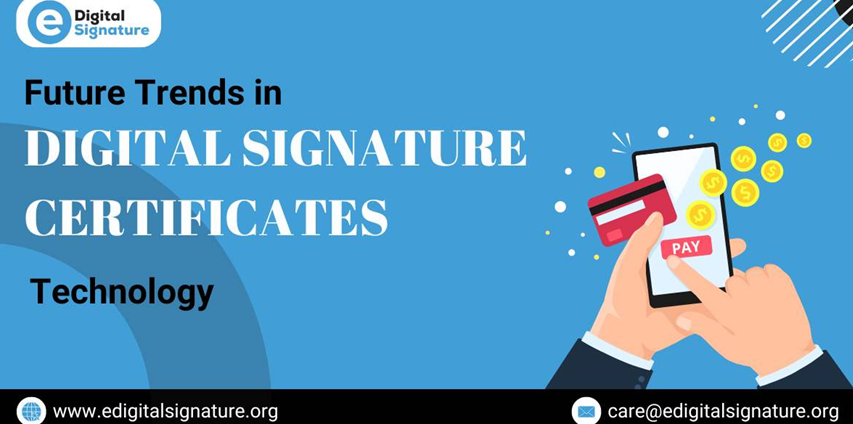Digital signatures and certificate technology have revolutionized the way we authenticate and secure digital communications and transactions. As technology evolves, so do the trends in digital signature and certificate technology. In this blog post, we’ll explore some of the key trends shaping the future of this critical aspect of cybersecurity.
A Digital signature certificate (DSC) is a secure digital key issued by a Certifying Authority (CA) that validates the identity of the holder when conducting electronic transactions or communicating online. It serves as a virtual equivalent of a handwritten signature or a stamped seal, confirming the authenticity of digital documents, messages, or software.
1. Blockchain Integration
Blockchain technology is gaining momentum as a secure and transparent method for recording digital transactions. Integrating digital signatures with blockchain can enhance security and trust. Blockchain’s decentralized nature ensures that once a Fashionviko digital signature is recorded, it cannot be altered or tampered with, making it an ideal solution for securing sensitive data and transactions. This integration can lead to more transparent and immutable records, critical for industries like finance, supply chain, and legal sectors where the integrity of documents is paramount.
2. Quantum-Resistant Algorithms
With the advent of quantum computing, traditional cryptographic algorithms may become vulnerable. To counter this threat, researchers are developing quantum-resistant algorithms for digital signatures. These algorithms aim to provide the same level of security as current methods, even in the face of powerful quantum computers, ensuring long-term data protection. Companies and governments are investing in quantum-resistant technologies to future-proof their security infrastructure against potential quantum threats.
3. Biometric Authentication
Biometric authentication methods, such as fingerprint, facial recognition, and retina scans, are becoming more prevalent. Combining these methods with digital signatures enhances security by ensuring that the person signing a document is indeed who they claims to be. This trend is particularly relevant in sectors requiring high levels of security, such as banking and healthcare. By leveraging unique biological characteristics, biometric authentication reduces the risk of unauthorized access and identity fraud.
4. Cloud-Based Digital Signatures
Cloud technology is transforming how businesses operate, and digital signatures are no exception. Cloud-based digital signatures offer flexibility and scalability, allowing users to sign documents from any location with internet access. This trend is particularly beneficial for remote workforces and global collaborations, making the process more efficient and accessible. Additionally, cloud-based solutions often come with robust security features, ensuring that digital signatures remain protected even in a decentralized work environment.
5. Enhanced User Experience
As digital signatures become more widespread, the focus on user experience is increasing. Future trends include simplifying the process of obtaining and using digital signatures, integrating them seamlessly into existing workflows, and making them more intuitive for non-technical users. This approach ensures broader adoption and enhances productivity. Innovations such as single sign-on (SSO) and seamless integration with popular productivity tools will make digital signatures a natural part of everyday operations.
6. Regulatory Compliance and Standards
With the growing use of digital signatures, regulatory bodies are establishing stricter guidelines and standards to ensure security and interoperability. Future trends will see an increase in the development of international standards for digital signatures, making cross-border transactions more secure and efficient. Staying compliant with these evolving regulations will be crucial for businesses. This compliance ensures that digital signatures are recognized and legally binding across different jurisdictions, facilitating smoother international business operations.
7. Artificial Intelligence and Machine Learning
AI and machine learning are being integrated into digital signature technology to enhance security and detect fraudulent activities. These technologies can analyze signing patterns, detect anomalies, and alert users to potential threats in real-time. This proactive approach to security ensures a higher level of trust in digital transactions. AI-driven analytics can also help organizations understand user behavior and improve the overall efficiency and security of their digital signature processes.
8. Mobile-Friendly Solutions
As mobile devices become increasingly central to business operations, digital signature solutions are adapting to be more mobile-friendly. Mobile digital signatures allow users to sign documents on the go, ensuring that business processes are not hindered by the need for physical presence. This trend supports the growing demand for flexibility and mobility in the modern workforce.
9. Decentralized Identity Verification
Decentralized identity verification systems are emerging as a way to enhance privacy and security in digital transactions. By leveraging blockchain and other decentralized technologies. Users can have more control over their personal information while still providing verifiable digital signatures. This approach reduces reliance on central authorities and minimizes the risk of data breaches.
10. Environmental Impact and Sustainability
As businesses become more conscious of their environmental impact. Digital signatures offer a way to reduce paper usage and the associated carbon footprint. Future trends will likely see an emphasis on the sustainability benefits of digital signatures. Promoting them as a green alternative to traditional paper-based processes. This shift not only helps organizations meet their sustainability goals but also reduces operational costs.
Read About: Digital Signature Certificate for GST
Conclusion
The future of digital signatures and certificate technology is promising, with advancements aimed at enhancing security, usability, and regulatory compliance. From blockchain integration and quantum-resistant algorithms to biometric authentication and AI. These trends will shape the way we secure our digital interactions. As technology continues to evolve, staying informed about. These trends will be crucial for businesses and individuals alike to maintain robust cybersecurity practices.
Embracing these future trends will not only protect sensitive data but also streamline digital processes, paving the way for a more secure and efficient digital future. By keeping up with these developments, organizations can ensure that they remain at the forefront of technological innovation, providing secure and efficient solutions for their users.
